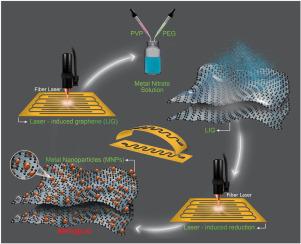用于柔性温度传感器的金属纳米颗粒装饰石墨烯的直接激光合成,调谐和图案
IF 8.2
2区 材料科学
Q1 MATERIALS SCIENCE, MULTIDISCIPLINARY
引用次数: 0
摘要
推动日常生活中智能的增强需要低成本的传感器将物理世界转化为数据,并帮助开发物联网(IoT)生态系统。用商用激光器直接激光写入低成本石墨烯传感器是一种有前途的定制制造传感平台的策略。本研究提出了一种基于全激光的工程有机-无机纳米结构的高灵敏度、耐用性和适形温度传感器件的制造技术。我们提出快速制造石墨烯-金属异质结作为通过修改塞贝克系数来调节石墨烯温度敏感性的关键解决方案。通过将不同的金属纳米颗粒(MNPs)集成到石墨烯基体中,包括镍、钴和铜,复合材料的电热性能可以用于各种传感应用。将铜纳米颗粒掺入激光诱导石墨烯(Cu-NPs@LIG)显著提高了温度灵敏度,在环境温度范围内的灵敏度高达- 1.04% /°C,在高线性度的零下温度范围内的灵敏度高达- 3.44% /°C。0.98)和最小迟滞。在初步发现的基础上,该研究进一步研究了聚合物涂层对温度传感性能的有趣影响。结果表明,在Cu-NPs@LIG传感器上涂覆聚酰亚胺(PI)和聚偏氟乙烯(PVDF)等涂层可显著提高传感器的灵敏度,最高可达81%。Cu-NPs@LIG传感器的环境稳定性在不同湿度水平下的封闭腔室中进行了评估,其中pvdf涂层传感器表现出优异的稳定性,具有一致的灵敏度和最小的基线漂移。提出的制造工艺为高性能柔性温度传感器提供了快速、低成本和可扩展的路线,为医疗监控、智能包装、软机器人和基于物联网的系统的应用提供了新的机会。本文章由计算机程序翻译,如有差异,请以英文原文为准。

Direct laser synthesis, tuning, and patterning of metal nanoparticles-decorated graphene for flexible temperature sensors
Driving the enhancement of intelligence in everyday life requires low-cost sensors to translate the physical world into data and help developing the Internet of Things (IoT) ecosystem. Direct laser writing of low-cost graphene-based sensors with commercial lasers is a promising strategy for customized fabrication of sensing platforms. This study presents an all-laser-based fabrication technique for highly sensitive, durable and conformable temperature sensing devices made of engineered organic-inorganic nanostructures. We propose rapid fabrication of graphene–metal heterojunctions as a key solution to tune the temperature sensitivity of graphene by modifying the Seebeck coefficient. By integrating different metal nanoparticles (MNPs) into the graphene matrix including nickel, cobalt, and copper, the electrothermal properties of the composites could be tuned for various sensing applications. Incorporation of copper nanoparticles into laser-induced graphene (Cu-NPs@LIG) significantly enhanced the temperature sensitivity, achieving a sensitivity of up to −1.04 %/°C for ambient and −3.44 %/°C for sub-zero temperature ranges with high linearity (R2 > 0.98) and minimal hysteresis. Building on the initial findings, the study further investigates the interesting effects of polymer coatings on temperature sensing performance. It was observed that applying coatings such as polyimide (PI) and polyvinylidene fluoride (PVDF) on the Cu-NPs@LIG sensors significantly improved the sensitivity of the sensors up to 81 %. The environmental stability of the Cu-NPs@LIG sensors was evaluated in a closed chamber under varying humidity levels, where PVDF-coated sensors exhibited excellent stability with consistent sensitivity and minimal baseline drift. The proposed fabrication process provides a rapid, low-cost, and scalable route for high-performance flexible temperature sensors, unlocking new opportunities for applications in healthcare monitoring, smart packaging, soft robotics, and IoT-based systems.
求助全文
通过发布文献求助,成功后即可免费获取论文全文。
去求助
来源期刊

Materials Today Nano
Multiple-
CiteScore
11.30
自引率
3.90%
发文量
130
审稿时长
31 days
期刊介绍:
Materials Today Nano is a multidisciplinary journal dedicated to nanoscience and nanotechnology. The journal aims to showcase the latest advances in nanoscience and provide a platform for discussing new concepts and applications. With rigorous peer review, rapid decisions, and high visibility, Materials Today Nano offers authors the opportunity to publish comprehensive articles, short communications, and reviews on a wide range of topics in nanoscience. The editors welcome comprehensive articles, short communications and reviews on topics including but not limited to:
Nanoscale synthesis and assembly
Nanoscale characterization
Nanoscale fabrication
Nanoelectronics and molecular electronics
Nanomedicine
Nanomechanics
Nanosensors
Nanophotonics
Nanocomposites
 求助内容:
求助内容: 应助结果提醒方式:
应助结果提醒方式:


